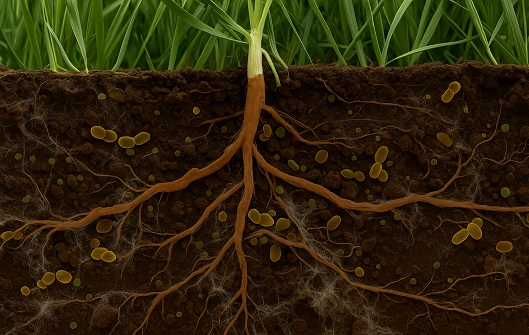An international research group involving the University of Bern has discovered that soil
microorganisms shift their seasonal rhythm more than plants in response to climate warming.
The resulting discrepancy between plants and microorganisms could disrupt essential
ecosystem processes and jeopardize their functionality.
Bern, 05 Aug, 2025.- Most living creatures follow a certain rhythm throughout the year. This determines, for example, when they reproduce, when they go into hibernation or when other important life processes take place. Thisregular annual cycle is known as phenology. It is important for the survival of species and for thefunctioning of ecosystems. One of the most common reactions of animals and plants to climate change are changes in this annual rhythm – for example, the flowering of many plant species now begins earlier in their growing season or there are shifts in the timing of the breeding season for animals.
While phenological shifts in plants and animals have been well researched, the extent to which climate warming affects the phenology of soil microorganisms compared to the phenology of plants has remained unclear. This is where a study recently published in Nature Geoscience by an international research group from Lanzhou University, East China Normal University and the University of Bern comes in. Their results show that the microbial phenology in soils shifts more strongly than that of plants as a result of climate warming. This as yet overlooked discrepancy could have negative impacts on the ability of ecosystems – for example, to store carbon or recycle nutrients.
Soil respiration as a key indicator
To investigate how microbial phenology responds to climate warming compared to plant phenology, the researchers conducted a meta-analysis of around 1,000 global experimental studies showing phenological shifts in plant or microbial soil respiration in response to experimental warming in different ecosystems. Plant and microbial soil respiration is the release of carbon dioxide (CO₂) from the soil caused on the one hand by cellular respiration of living plant roots (plant) and on the other hand by the decomposition of organic matter by microorganisms (microbial). Depending on environmental conditions and seasons, soil respiration fluctuates, which is an important key indicator of the biological activity of plants and microorganisms. «This was an innovative approach,» says Prof. Dr. Madhav P. Thakur from the Institute of Ecology and Evolution at the University of Bern and coleader of the study. «Using soil respiration data as a phenological marker allowed us to detect subtle but consistent shifts in biological rhythms that are otherwise difficult to observe.»
Hidden shifts in the soil
The results of the meta-analysis show that soil microorganisms react very sensitively to climate
warming, with a greater temporal shift in phenology than plants. In response to warming,
microorganisms start their activity earlier in spring and remain active longer than plants in fall.
«This shift is particularly pronounced in forest ecosystems and in carbon-rich soils, which are typical of colder regions,» explains Prof. Dr. Hao Wang from Lanzhou University and lead author of the study.
«It is striking that this discrepancy between plant and microbial phenology is a consistent pattern in all ecosystems, despite regional differences. We have long assumed that plants and microorganisms
work in synchrony, but our results show that climate warming is gradually undermining this
synchrony,» Thakur continues.
Consequences for ecosystems
This desynchronization between plants and soil microorganisms could affect essential processes such as carbon storage and the flow of energy and nutrients in ecosystems. «This raises concerns about their resilience in a warming world,» says Thakur. «The phenology of soil microorganisms could thus be a hidden factor in climate feedbacks that amplify the negative consequences of climate warming,» Thakur warns. «If the mismatch between the seasonal rhythm of plants and microorganisms persists, it could destabilize the core processes of ecosystems that support their functioning,» Thakur continues.
Building on the new findings, the Terrestrial Ecology research group at the Institute of Ecology and
Evolution at the University of Bern will now conduct further experiments. As part of the long-term
outdoor experiment «Hasli Outdoor Mesocosm Experiment (HOME)» at the Hasli Ethological Station, the effects of various stress factors, such as climate warming and drought, on plant, insect and microbial communities and on the functioning of ecosystems will be further investigated.









